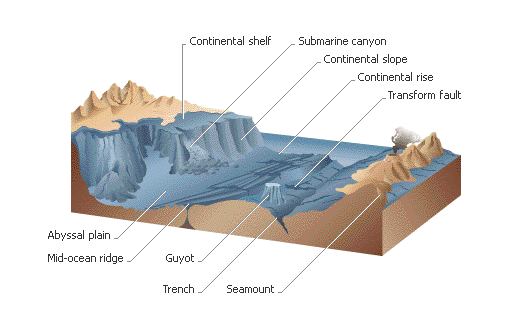

Once scientists were able to map the ocean floor, they discovered something surprising. The bottom of the ocean was not a flat, sandy plain stretching between the continents, as many people once thought. In fact, the ocean floor was rocky and dramatically uneven. Many previously unknown features of the seafloor were discovered.
Extending out from a continent's edge is a gently sloping, shallow area called the continental shelf (F). At the edge of the shelf, the ocean floor drops off in a steep incline called the continental slope (A). The continental slope marks the true edge of the continent, where the rock that makes up the continent stops and the rock of the ocean floor begins. Beyond this slope is the abyssal plain (C), a smooth and nearly flat area of the ocean floor. In some places, deep, steep-sided canyons called trenches (G) cut into the abyssal plain. A continuous range of mountains called the mid-ocean ridge (D) winds around Earth. There are mountains on the abyssal plain, too. Some reach above the ocean surface to form volcanic islands (E). Others, called seamounts (B), are completely under water.
To understand how ocean-floor features are formed, it is important to understand the Earth's structure. The Earth consists of layers around its center, or core. The outer layer, or crust, is thin and rocky. The thick layer between the crust and the core is the mantle. It contains hot, liquid rock called magma. Magma flows out of the mantle and onto the surface through cracks in the crust. Magma on the surface of the Earth is called lava, which hardens to form new crust.
Earth's crust is broken into large plates that float on the mantle. As these plates slowly move, they create different landforms. The mountain ranges of the mid-ocean ridge, trenches, and underwater volcanoes are all formed by interactions of Earth's plates. At the mid-ocean ridge, plates are diverging or moving apart. Magma squeezes up though cracks between the plates and hardens to form new rock. Newer eruptions push the older rock away from the ridge in a process called sea-floor spreading. Over millions of years, sea-floor spreading created the ocean floor.
Diverging
Plates
Even though new ocean floor is constantly being created at the mid-ocean ridge, Earth always stays the same size. That is because while divergence is occurring at the mid-ocean ridge, convergence, where two plates come together, is occurring at a different location on the plate. When two plates converge, one plate sinks under the other plate and old rock sinks into a trench and back into the Earth's mantle.
